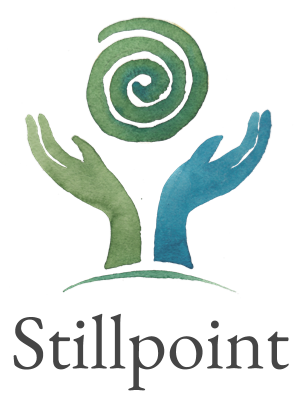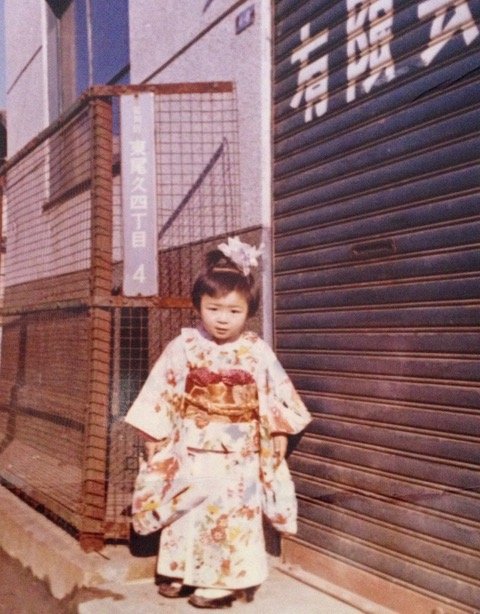Beneath and Beyond Language
By Takako Terino,
The Art of Spiritual Direction at Ghost Ranch Faculty
Dressed for the Summer Festival in the Shinto Tradition, Takako is on the far right.
I write this with a heart full of gratitude for Stillpoint, who has not only introduced me to the art of spiritual direction but also to the ever-growing community of spiritual companions and seekers of contemplative life. I wish I could meet each one of you reading this blog!
As someone who made a living as a bilingual interpreter and translator, I was always keenly aware of the primary lived experience veiled behind the language that was more expansive than what language could capture and convey. Spiritual Direction, or deep listening, listens for that experience of the Spirit in the directee that is always unfolding, beneath and beyond the limit of our shared language, hidden in our consciousness waiting to be acknowledged, named and embraced. That is what I have learned through the Art of Spiritual Direction at Stillpoint Ghost Ranch. It has deepened and broadened both the experience and the expression of my own spiritual life in unexpected ways.
Takako at age three, dressed for the Shinto rite of passage.
The first spiritual language I acquired was a language of faith in the tradition of Protestant Christianity, and it remains my spiritual “native tongue.” My first spiritual home was a small church in downtown Tokyo, built and pastored by a single Japanese woman, Katsuno-sensei. She saw the burn-out rubble of a city that was Tokyo, soon after World War II and heard the call to build a house of God there. When Katsuno-sensei embarked upon this act of faith in post-war Japan, women (especially the unmarried) were deemed second-class citizens and Christians were a small minority. My mother, then in high school, joined her efforts and became one of the pillars of the church and she remains as such to this day. I was raised by these fiercely spiritual women of faith that defied constrictions of the patriarchy in matters spiritual.
I came to the United States as a teenager to attend a boarding school, and my journey through the variegated landscape of American Christianities began. Having had only two years of classroom instructions in Japan, I spoke little English. Little did I know that the kind of English I was acquiring in my early years in this country was what I now call “Evanglish” (my invented word)… that distinct language of faith and prayer spoken within the Evangelical Christian communities. I had nearly mastered Evanglish when I started to feel that my spiritual experience did not quite fit the shape of that particular language of faith. I felt my spirituality being shaped by that language, and at the same time I pushed back against that familiar constrictive voice of the heteronormative patriarchy.
After college, I moved to New York City and happened to walk through the doors of a church that belonged to Reformed Christianity, and I felt like I found my new spiritual home. The spiritual language that I learned to speak there was Reformed theology. It provided a secure container in which my spirituality could grow in depth and find expression; I had found my voice. It allowed me to continue the conversation with, and learn from, my Buddhist spiritual sister back home in Japan, and it also gave me a “home base” from which I could participate in interfaith collaboration. In fact, it was through such collaboration that I was able to appreciate anew the beautiful spiritual expression of Shintoism, which I had only known in the form that had been usurped by Japanese imperialism.
Yet, at some point, I had come to identify spirituality with the language of its expression itself; I was filtering spirituality only through a theological lens. The focus of my spiritual processing had shifted from the heart to my head. This became apparent during my Clinical Pastoral Education (CPE) residency. Then, a friend from my CPE cohort who was a spiritual director encouraged me to consider spiritual direction. I am forever grateful for her loving attention and intervention!
Fifteen year old Takako, shortly before moving to the US.
One day during the ASD residency at Ghost Ranch, I was invited to recall all the spiritually meaningful moments in my life, from the earliest that I could remember. Out of nowhere, a very clear memory from my childhood that I had not thought of in ages came rushing back, with the freshness of a dream from the night before. I must have been seven or eight. My family had moved from the concrete jungle of downtown Tokyo to a suburb where I could, for the first time in my life, run around and lie down in the grass. Somehow, without any prompting from anyone, I picked up a practice of grabbing my Disney alarm clock (I can’t remember if it was Cinderella or Snow White, but it was the kind that you wound up by hand) and wandering off into the grassy field behind the apartment complex where we lived. There, I would set the alarm for 15 minutes or so and “go.” Where to? I had no idea. Closing my eyes, I would simply yield myself to the flow that carried me into the space that was simultaneously within and without me. I had no language for it, but I knew someone, or something, awaited me there. Lying on the grass, with my limbs outstretched, I floated in the presence of the Spirit. Meditation? Apophatic prayer? It didn’t matter to me what it was called.
The moment I recalled this memory is best expressed in Derek Walcott’s poem ”Love After Love.”
“Love After Love”
The time will come
when, with elation
you will greet yourself arriving
at your own door, in your own mirror
and each will smile at the other's welcome,
and say, sit here. Eat.
You will love again the stranger who was your self.
Give wine. Give bread. Give back your heart
to itself, to the stranger who has loved you
all your life, whom you ignored
for another, who knows you by heart.
Take down the love letters from the bookshelf,
the photographs, the desperate notes,
peel your own image from the mirror.
Sit. Feast on your life.
I was brought face to face with my long-forgotten self, for whom spirituality was not a thought or a language but an experience. Stillpoint’s Art of Spiritual Direction program brought me back in touch with that “self” who is the locus of my spirituality. Spiritual Direction and other contemplative practices help me to stay connected with “her” and to remember to take with me everywhere I go the one who resides in the space beneath and beyond language.
Takako Terino Born and raised in Japan, Takako came to the US as a teenager and has lived in a variety of faith communities. Her experience as a religious minority in Japan and then a racial-ethnic minority in the US, combined with her professional experience as interpreter/translator, has given Takako sensibility for the language of cultural, theological and spiritual heritages unique to each individual. Takako received the Master of Divinity degree from the Union Theological Seminary in NYC and her spiritual direction training from Stillpoint. She is a clergy member of the Presbyterian Church (USA) and lives in Albuquerque, NM.




